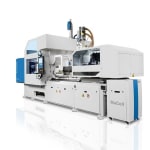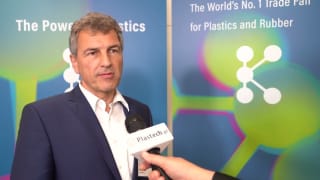 Compared to conventional articles, MuCell parts are exceptionally lightweight and can be developed in almost no time and on smaller machines with low operating costs. In combination with special mold concepts and in cooperation with partners, KraussMaffei has succeeded in creating additional high-gloss surfaces for the foamed components. At KraussMaffei's booth at the NPE (West Hall Level 2 Hall A, Booth W903), a fully electric AX 180-750 CellForm production cell with integrated LRX 50 produces foamed visible components with premium quality surfaces in piano black.
Compared to conventional articles, MuCell parts are exceptionally lightweight and can be developed in almost no time and on smaller machines with low operating costs. In combination with special mold concepts and in cooperation with partners, KraussMaffei has succeeded in creating additional high-gloss surfaces for the foamed components. At KraussMaffei's booth at the NPE (West Hall Level 2 Hall A, Booth W903), a fully electric AX 180-750 CellForm production cell with integrated LRX 50 produces foamed visible components with premium quality surfaces in piano black.Trend highlights premium quality surfaces
The MuCell process is a physical foaming process that uses gas. The primary advantages of the foamed components are the light weight and short manufacturing times. "The MuCell process has become an established technology, particularly in vehicle manufacturing and for technical components. However, the trend is clearly moving towards also using the process for premium quality surfaces in visible components," explains Paul Caprio, President of the Krauss-Maffei Corporation in the USA.At its booth at the NPE, KraussMaffei is demonstrating live how these requirements can currently be implemented: a fully electric AX 180-750 CellForm production cell with integrated LRX 50 will produce foamed visible components with premium quality surfaces in piano black. This is made possible by features including inductive dynamic mold heating (DMH) from RocTool and Roctooling mold expertise. The molds have special surfaces with different effects (matt, high-gloss, with punched holes), providing an impressive showing of the design options for foamed visible components.
However, the molds and mold heat-balancing are not the only critical factors for the success of the MuCell process. Special screws, plasticizing units, barrels and control system and process control system are also required for the process. They are an important component of the KraussMaffei CellForm technology, which was developed specifically for the MuCell. KraussMaffei is also featuring an AX 180-750 CellForm as a highlight of its exhibit at the NPE trade show. The high precision and shot weight consistency of this fully electric injection molding machine make it particularly well suited for the MuCell process. At the same time, it enables a reduction in energy consumption. A panel for coffee machines will be produced at NPE from state-of-the-art technical polycarbonate. By adapting the part design specifically to MuCell, the wall thicknesses and part weight were adjusted in such a way as to achieve significant material savings with no loss of functionality. This not only lets us keep the weight down, but also conserves resources - an important step towards greater sustainability in production," says Caprio.




